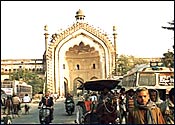|
|
|
|
|
|
|
|
|
| Lucknow Introduction |
|
 In the approximate centre of Uttar Pradesh, 516km east of Delhi, the state capital LUCKNOW is best remembered for the ordeal of its British residents during the five-month siege of 1857. Today, Lucknow's fading nineteenth-century monuments bear the scars of the fighting, and of the destruction wreaked by the British army when they regained control. Lucknow is associated with its legendary hospitality, leisurely moods of life, world-renowned cuisine and exquisite Sham-e-Avadh. In the approximate centre of Uttar Pradesh, 516km east of Delhi, the state capital LUCKNOW is best remembered for the ordeal of its British residents during the five-month siege of 1857. Today, Lucknow's fading nineteenth-century monuments bear the scars of the fighting, and of the destruction wreaked by the British army when they regained control. Lucknow is associated with its legendary hospitality, leisurely moods of life, world-renowned cuisine and exquisite Sham-e-Avadh.
|
|
|
Top ˆ |
|
|
| Lucknow Tourist Attractions |
|
|
| § Bada Imambada |
|
The Bada Imambada (Asafi Imambada: patriarch's place) is an important tourist attraction of Lucknow. Next to the Imambada, in the same compound, is a majestic mosque and to its right, a row of cloisters concealing a huge well, which is said to be fathomless. |
|
|
| § Chota Imambada |
|
Chota Imambada is an exquisite building built by Nawab Muhammad Ali Shah in 1839 as a burial place for himself. As you enter the compound, you step into a large courtyard with a rectangular raised tank spanned by a small bridge. |
|
|
| § Jama Masjid |
|
Then there is the Jama Masjid, a great mosque with two minarets and three domes, which stands to the west of the Hussainabad Imambada. It also owes its origin to Muhammad Ali Shah who started the construction but did not live to see it completed. That task was left to Begum Malika Jahan of the royal family. |
|
|
| § Clock Tower |
|
The Hussainabad Clock Tower, rising to 221 feet, was started in 1880 and completed seven years later. The clock itself, which was designed by M. J. W. Wanson of London, is said to be the largest in India. |
|
|
| § Residency |
|
Nawab Saadat Ali Khan built the Residency in 1800 for the British Resident at his court. Originally a very extensive and beautiful building, it received heavy shelling during 1857, when the First War Of Indian Independence took place. The red building is today in a dilapidated state and marks of cannon shots can be seen on almost every wall. |
|
|
| § Chattar Manzil |
|
Chattar Manzil that served for a while as the palace of Begum Hazrat Mahal , the heroine of India's first fight for independence against the British. For English travelers in the 19th century, it seemed like something out of Arabian Nights! Today this splendid building houses a prosaic Drug Research Institute. |
|
|
| § Kaiser Bagh Places |
|
Among the other fabulous monuments of Lucknow are the Kaiser Bagh palaces, built by Wajid Ali Shah, the last Nawab of Avadh, who was robbed of his kingdom by the British. There are several small pavilions for the performance of plays. The surrounding yellow buildings called Lakhi were, at one time, the harem. |
|
|
|
|
Top ˆ |
|
|
|
|











